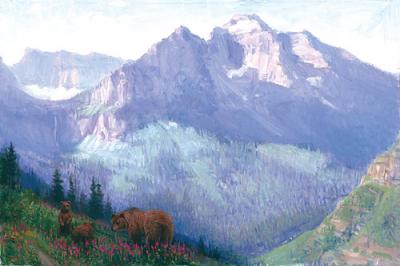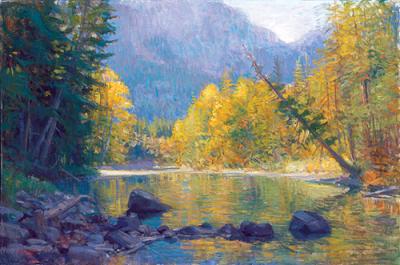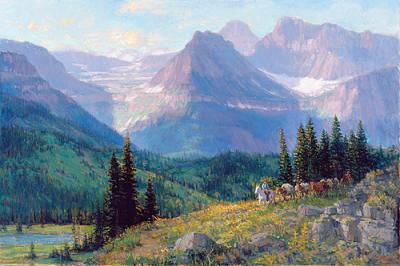Montana Artist Joe Abbrescia

A breeze glides up the sloped meadow, brushing you softly and then slipping off into the trees. Patches of Indian paintbrush and kinnikinnik variegate the dusty emerald grasses. The lake past the far bottom of the meadow reflects mountain, cloud and sky and adds impressionist glimmer to the image. Beyond the lake, talus and forest shimmer and darken with passing clouds and above it all is “The Mountain”, glaciered and imperial.
There have been few gifted artists who are able to capture that immensity and grandeur in their work; Joe Abbrescia is certainly a member of that group. His paintings lend the viewer that thrill of seeing the epic West in person. The mountains soar and the foreground pastures seem both solid and nostalgic, reminding the viewer of a time he might have spent in a similar meadow, exulting in its natural sublimity. In the unwatched corners of the viewer’s mind he goes to the mountains and he feels the elation of being there again.

Joe had an individualist philosophy on art. He understood that style was intensely personal, and he disliked the idea that a student might imitate his style. “You’re in control of your own understanding. Put some trust in there,” he said to a group of developing students, urging them to take from his teachings what they wanted and mix it into their own style. He tried to guide students, to point them in the right direction instead of teaching them a collection of rules. In fact, in his classes he seemed to consider himself the leading student in a teacherless group. Joe’s wife Sue says, “He was always a great communicator. He’d ask lots of questions, trying to find out what people personally were trying to get out of their painting. He was able to teach them to paint as they wanted to, not as he did.”
“He never stopped trying to learn how to paint a better painting,” says Joe Jr., who currently runs an art restoration firm as part of the family’s gallery in Kalispell. “He struggled just as hard with his last painting as his first. He was always trying to discover new compositions and new colors. I’d find him looking at a six-month old painting, and he’d take it off the wall and put it away, saying, ‘That one isn’t good enough now. I can do better.’ He told me it never got any easier, no matter how much he had learned.”
Sue adds, “He used to tell me when he was working on a painting that he felt like he had never painted before.”

Joe delighted in sharing little techniques. He showed a colleague how to paint turpentine over oil in and then wiped it off, taking much of the paint with it. He turned and said with glee, “Now by gosh, you can do some nice drawing with that!”
Joe believed in learning the rules of art until they were instinctual, then letting them go. He advised students to get rid of the intellectual side when painting, to feel it instead of thinking it. To Joe, painting was not a series of discrete steps where canvas is sized, followed by laying down the major shapes and finally adding nuance at the end. Painting was a great continuum, where the steps blended and swirled like the oil on the canvas. He used personal distractions as a way of keeping the logical part of his mind at bay. “One of the best paintings I’ve made was done on a cliff. I was right on a slippery edge, and I had to be very aware and keep a close eye on that edge. I discovered afterwards that that distraction of my conscious mind had allowed my intuition free reign to make the painting.”
And there was always humor. When a colleague asked him which was his best painting, he replied, “Oh, all my masterpieces were painted in my head. They were pretty good, you know.”
He was charming. He was handsome like a mid-century movie star, and his voice evinced his confidence in what he was saying. His hands were part of that voice, constantly in motion, illustrating the words. When he spoke to someone, it wasn’t with a sidelong glance, but with both eyes and with absolute attention.

That same focus was given to his canvas when he painted. Joe was a physical man. His shoulders were wide and his arms long and were always held flexed, at the ready, capable at once of wide and aggressive brush strokes and fine manipulation at the fingertips. He stood at his easel with legs spread wide, the right one forward, as if he was about to sprint. He bobbed and lunged like a boxer, his head flitting continuously from subject to painting and back. His body was kept loose and supple. He jabbed at the canvas, sure of his instinct and the connection between mind and brush, and that connection was evident when watching him. The bristles of the brush were the end of the armature starting at his spine; each piece of him moved in compliment and concert to see the image and bring the brush to the canvas, and through it all flooded energy. The constant movement was another distraction, another way of disorienting the intellect so the intuition could hold sway. “I like to keep moving so that I don’t notice one thing and start thinking too much about it,” he explained to his students.
Joe was born in 1936 in the Bronx, the second of three brothers. When Joe was 11, the family moved to Chicago, where Joe would spend his developmental years in art. Joe always seemed to know he would be an artist; there had never been a serious question of it. His family encouraged his work unconditionally. He attended classes at the American Academy of Art before joining the Army in the mid 1950s. He worked as an illustrator during his service, and while stationed in Alaska he found that some of the officers’ wives wanted to learn to paint, so he started giving informal classes. After the military, he took the experience he had gained from his teaching and with his father and brother opened the Village Art School in Skokie, IL, an institution still run by his brother Dominic. Around that time he met Sue on a blind date, and they were married three years later.
His own discovery of the West reflected the same feeling of euphoria-in-nature that would soon emerge in his mountain paintings. “He and his brother had been coming to the western states to deal in art, and on one trip they drove through Glacier. That’s how we got here,” says Joe Jr.
Sue recounts the event: “He came home from that trip excited and said, ‘I’ve just been in the most beautiful place! We’re going to live there,’ and that was that. He had already shown with the Ace Powell Gallery and so had some experience with Kalispell. We came here in 1976. He said he wanted to ‘come paint the beauty.’”

The family moved to Arizona through the 1980s, but eventually the glory of the Montana landscape pulled them back home and upon their return, they wondered why they had ever left. In 1993 they opened the Abbrescia Fine Art Gallery in Kalispell to show Joe and Sue’s (a ceramic artist in her own right) work. He had painted in Venice, Paris, New York, and Mexico, but always returned to his beloved Glacier Park to paint his most personal work.
Joe had always shown in the Russell Auction in Great Falls, and among his numerous awards are three Best of Shows and two People’s Choice Awards from that popular event. He was a prolific painter and has sold many paintings throughout his lifetime, not only to Montanans but to art collectors across the globe. “We don’t see as many of his paintings coming up for sale as we’d have expected,” says Joe Jr. “People may buy them initially as investments, but they seem to end up falling in love with them and keeping them for their personal collections. We hear over and over again that when people buy his work, they never tire of viewing it. They see something new every time they look at it.”
But Joe wouldn’t have wanted his work to be hidden from those others who might find beauty in it. The Abbrescia Fine Art Gallery has recently been creating Giclée prints of Joe’s paintings so that they are more available to the public. “Giclée is our main effort now,” says Joe Jr. “It’s the best way for people to see and be able to own his work.” Giclée is a relatively new process using very high quality digital scans to make prints of work that rival the original not only in appearance, but also in longevity. “They’re all archival materials and have extra UV protection,” says Joe Junior. The prints are on canvas and are strikingly accurate.
Joe died on February 27, 2005, after having done the best someone can do: he added to the total beauty of this world, and he taught others how to do the same.
The Abbrescia Fine Art Gallery is located at 12 First Avenue West in Kalispell. They can be reached at (406) 755-6639 or at [email protected]
~ Rennan Rieke writes, photographs, and plays jazz upright bass in Helena, Montana.
Leave a Comment Here
Leave a Comment Here